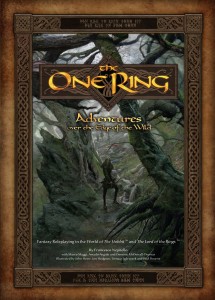I’ve been running The One Ring with my weekly gaming group lately. It is a fun new roleplaying game set in Middle Earth. Like basically every RPG that uses a more organic skill and ability advancement system (rather than a leveling system), it doesn’t provide guidelines for setting appropriate challenges for fights and encounters. Rather, the GM is left to craft encounters as appropriate to the story rather than trying to make each fight level appropriate.
In some ways this is liberating. For example, in my latest adventure, my foe was an Orc Chieftain with a small army of 50 Orcs at his command, with plans to expand his numbers through alliances and browbeating other Orc tribes. It felt right that an up and coming Orc leader would have a pretty sizable force. I figured he had a good number of his forces out doing things: attacking travelers, staging raids on settlements, and proposing alliances with other orc tribes. Of course, he would still keep 15-20 Orcs behind to protect his camp, work a mine right next to the camp, and respond to any additional threats.
So that’s what the PCs had to deal with. During their travels to the camp, they encountered one of the small group of Orcs sent out to harass travelers and easily dealt with them. When they arrived at the camp, they devised a plan to distract the main group of Orcs so they could attack the Orcs working in the mines. Then they collapsed the entrance of the mine so the other Orcs couldn’t get to them right away.
After dealing with the Orcs in the mine, they prepared for an assault from the main force outside of the mine who were using pickaxes to dig through the entrance. They devised a clever plan to kill the first Orcs through the entrance with a mining cart and a steep constructed track. Then they’d fight the rest. The plan went off without a hitch, and they killed 6 of the first group of Orcs.
That left them with 4 Orcs, the Orc Chief, his Lt., and his Advisor to deal with. It turns out just the Chieftain would have been enough. I used the stats for a “Great Orc” from the rulebook and gave him a nasty magic weapon to boot. The result was a extremely deadly near invincible enemy that the PCs had virtually no chance to defeat. One PC was knocked unconscious, the other fled the battle, and another surrendered.
So what’s my point? If I’d had an Encounter Level chart and Challenge Rating to work with, this would never have happened. I’ve had TPKs in D&D 4th edition before, but with those fights I almost always felt like the party had a fighting chance. And they were fights I designed to be tough, with high encounter levels. In a system like The One Ring, I could throw a single Troll at the party and not know whether the fight is going to be a cake walk, a massacre, or a decent challenge. As I get used to the system a bit more, I should have a better idea, but I suspect I will never get anywhere close to the specificity that D&D offers, which is going to make for a lot more TPKs and super easy fights. Not the end of world, but definitely something to be aware of when running, playing, or designing a non-level based RPG.
To Summarize: Systems without formalized challenge ratings or encounter levels for designing fights tend to have the following strengths and weaknesses:
- More “organic” challenges.
- More “out of the box” thinking from the player and GM.
- More fights that are not challenging to the players.
- More TPKs!








That’s exactly my long experience with GURPS. You can plan in a range of challenge, but the Boss Wizard might go down in a single critical hit to the eye while a nameless NPC spearman might make every defense roll and carve up a much stronger PC before he drops.